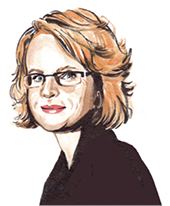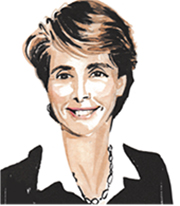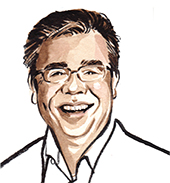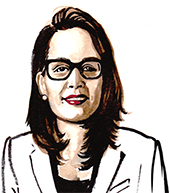
 Glenda Crisp, Senior Vice President and Chief Data Officer, TD Bank Group &
Glenda Crisp, Senior Vice President and Chief Data Officer, TD Bank Group &
Connie Bonello, Associate Partner, Financial Services, IBM Canada
IN MOST OF TODAY’S ORGANIZATIONS, data underpins every transaction, operation and interaction. And yet, the ability to extract its value and convert it into actionable business insights remains elusive to many. Based on our experience, the management, care, protection — in short, the governance of data — forms the foundation that enables powerful data-driven insights to emerge.
Data governance addresses some fundamental questions: Where is our information? What data is critical? How can we get at it when we need it, in the form we need it in? Can we trust it? And, How do we manage it?
Four years ago, the emerging consensus within TD Bank Group was that more could be done to meet growing expectations to use data to add value to the customer experience. To gain a deeper understanding of the challenge, TD conducted interviews with over 200 of its senior leaders. Among the themes that emerged: Data was being managed primarily at the business level; from an enterprise perspective, the ability to trace the flow of data and identify data sources could be enhanced; and analytics and reporting were siloed, with capabilities dispersed between several teams and systems, resulting in inefficiencies. Senior executives agreed that the business implications of these challenges — along with the ever-growing amount of data TD was collecting — warranted a complete data transformation program.
TD was the first of Canada’s big-five banks to appoint a Chief Data Officer (CDO) in 2013. The CDO [one of the authors] is a member of the senior management team, helping to ensure that the bank’s data strategy is aligned with business priorities and that the data implications of those priorities are taken into consideration. Upon joining TD, the CDO established an Office of the Chief Data Officer (OCDO) in Toronto and Cherry Hill, New Jersey. The first tasks were to develop an Enterprise Data Strategy, establish data stewardship roles within the individual lines of business, and pilot Data-Issue-and-Change and Data-Quality-Management processes.
TD also engaged senior executives from each line of business as ‘Data Sponsors’, to ensure line-of-business data strategies were aligned with the enterprise strategy. Each executive Data Sponsor is responsible for providing funding, driving data governance and quality and appointing ‘stewards’. The bank now has over 300 Data Stewards, who report to the line-of-business Data Sponsor and are responsible for executing on the data strategy. Already, projects that engage Data Stewards have realized better outcomes.
One of the key lessons learned during TD’s data transformation journey to date has been the need to have simple processes in place to ensure widespread adoption of a data strategy. For example, the original data quality process document was 141 pages long and included 46 steps. Feedback was that it needed to be
streamlined. To address this, TD engaged IBM to conduct a full-day workshop with its Data Stewards to help simplify the data-quality processes and enable the adoption of data quality tools. This resulted in the data quality process being reduced from 46 to 17 steps.
In general, TD has taken a test-and-learn approach to data governance, piloting everything with the Data Steward community and then adapting processes based on real experiences. It also conducts partnership surveys to get feedback on the overall effectiveness of its data governance program and to determine if Data Stewards have the resources and support required to execute the strategy. The bank chose to build its own Data Issue & Change Governance tool — an enterprise-wide repository of all data issues and proposed data changes. This tool gives the CDO visibility across the organization and enables her to look for patterns in issues that arise, which — if solved once — can benefit other parts of the organization.
For other aspects of its program, TD chose a licensed-solution approach, implementing IBM’s InfoSphere Information Governance Catalog and InfoSphere Information Analyzer. The former is a data quality profiling and analyzing solution that helps to derive more meaning from enterprise data, reduces the risk of proliferating incorrect information, facilitates the delivery of trusted content, and helps to lower data integration costs; while the latter is a metadata business glossary and data lineage solution that encourages a standardized approach to discovering data assets.
Today, TD continues on its quest to build enterprise-data capabilities. Rolling out Metadata Management and Data Quality tools across the organization remains an immediate priority. In addition, TD is developing a job model, career path and certification program for its Data Stewards.
Success factors identified for the program include line-of-business support that has a clear understanding of the value of enterprise-level data governance policies and standards; the use of automation and technology to facilitate data quality, traceability, monitoring and accountability; and a funding model that supports foundational investments for enterprise-wide solutions as well as longer-term goals. Above all else, TD’s investment in its people — through both the Data Steward community and the OCDO team itself — has been critical to the success of its data-governance journey.
 Jon Zimmerman, VP and General Manager, GE Healthcare (Seattle)
Jon Zimmerman, VP and General Manager, GE Healthcare (Seattle)
DIGITAL ISN’T ALL BRAND NEW; many of us have been at this for nearly 40 years. I call us ‘digital natives’, and we’re people who have spent many years working with digital technology, but who remain passionate about it and eager to solve the latest challenges in the industries we serve.
What is new today is the ability to do advanced processing thanks to significant new ubiquitous connectivity, storage and computing power. The biggest evolution I’ve seen in my time is Cloud computing. It is a major game changer. Those of us who have worked with digital technology for a long time are starting to figure out how to embrace the power of the new technologies in combination with what is already out there.
There is incredible digital power in healthcare: The ability to take a picture inside of somebody’s heart, from the outside — without disturbing them — is an incredible accomplishment in and of itself. The question is, could that idea be applied to delivering better care in more places or to developing better therapies through applied intelligence? These are the kinds of questions that keep digital natives engaged.
The outcomes that our customers want us to work with them on fall into four main categories: clinical quality, operational efficiency, financial performance and research. We work a lot on the financial side, because the U.S. has a very complex payment system. All too often, doctors do great work, but they aren’t paid for it: If the appropriate information about a patient and provider encounter is not received, the payer has the right to deny payment. Denied cases add up to $2 billion per year.
To address this, we developed DenialsIQ, which contains algorithms that turn the payers’ confusing codes into plain English, so providers can understand the root cause for the denial. The hope is that the system can eventually take outputs from Denials IQ and change how claims are created in the first place, to avoid problems — creating what I call a ‘self-healing revenue cycle’. One customer recently told me, ‘We would spend 90 per cent of the time discovering the cause and 10 per cent fixing it; now, the percentages are reversed.’
One of the biggest healthcare challenges, operationally speaking, is that demand far outstrips supply in terms of clinical professionals, and that will only increase as the population gets older and sicker. How do you keep up with that? Well, you better have some really good information systems in place, to facilitate the best possible flow of information and care. We need tools to help doctors and nurses be more efficient in their daily work, and that’s a big part of what we do.
I don’t really believe in artificial intelligence. First, there is nothing artificial about the intelligence generated from computer algorithms. It is real intelligence. It can be impactful to all the things we just talked about — clinical, financial, operational and research outcomes. Secondly, I also try to help our colleagues and customers realize that if intelligence is not applied, it doesn’t really matter. If there is a discovery in terms of efficiency, quality or finances, our customers expect us to put it to work to create an outcome for them. In my time, I’ve seen way too much innovation for the sake of innovating — but not really moving the ball forward to achieve an outcome. That’s why we try to have a discipline whereby all the ‘intelligence’ that we can generate with these new computing capabilities and networks is applied to a problem. That way, it’s sustainable and valuable, and it meets customer needs.
One of the biggest challenges for any company is getting to a place where you have consistent data across the organization. Before you can start working to make your data consistent — or to ‘normalize’ it, as we say — you first have to understand its current state: What you are capturing right now, where it comes into
the system, how it gets there, etc. The reason data is so variant across organizations is simple: We’ve had 40 years of computer systems that have basically been run out of context with one another. That’s why data is so diffused.
Once your data becomes normalized, you can start to discover patterns across your various systems — and it is those patterns that will help you identify inefficiencies or quality disparities.
 Thayde Olarte, Vice President, Consumer & Micro-Finance, International Banking, Scotiabank
Thayde Olarte, Vice President, Consumer & Micro-Finance, International Banking, Scotiabank
AS WE WORK TO MOVE THE BANK FORWARD DIGITALLY, we are taking a holistic view that has four parts to it. First, the customer is at the centre of everything we’re doing. Second, we are building partnerships with fintechs and other organizations to help us leverage our digital transformation. Third, we are fostering a culture where everyone becomes more agile by enhancing our processes and investing in technology. And fourth, innovation is key to our approach. Each and every Scotiabanker is expected to ‘own’ innovation.
We have been very ambitious in setting targets for 2021. By then, we aim to be the leading digital bank in our key markets. In my role, I’m responsible for creating a bridge between the fintech ecosystem and the bank. At the moment, we’re particularly focused on the Pacific Alliance countries — Mexico, Chile, Peru and Colombia, but we have a global mandate. In order to collaborate with fintech, we need to have access to venture capital, incubators and accelerators. The goal is to be ahead of the game and accelerate innovation.
Our fintech partnerships are mainly about one thing: learning. We have so much to learn from them, with respect to how they work, the models they use, and how focused they are on the customer. They also inspire us with how lean and agile they are. We’ve got a lot to learn. The second piece is about gaining the required capabilities to enhance our position. We need to use the experience and capabilities of our people more effectively. And the third piece, of course, is investment. We have to invest in the most promising fintechs that will help us progress to a digital leadership position.
Two of the fintechs we’re working with are based in Mexico. One is a financial comparison site which works as a digital lead originator for several products in that market; and the second one is a digital small business lender leveraging non-traditional data to adjudicate loans. The beautiful thing about these partnerships is that the fintechs recognize that they also have a lot to learn from us — from a regulatory, legal and operational perspective. For example, we can teach them how to handle a critical mass of customers.
Partnering with fintechs does present some risk, but it is a type of risk that can be kept under control. Two years ago, I would have said I was very concerned about being disrupted by a fintech; but today, frankly, we are not concerned, because we have faced up to these disruptive forces, and we now know that Fintechs are not going to have a future without the big banks.
Millennials are important to our strategy going forward, and we are already targeting this group in the Pacific Alliance countries, learning about what works best for them. As part of the customer life cycle, we need to develop appealing products and services for these people as they age. We recognize that we have to start early, but at the same time, we have to be ready for their future.
For any organization to embrace digital transformation, it has to start at the very top, so that the message cascades down. Having a CEO who is committed to digital transformation is very inspirational for people; but at the same time, as we say every day, everyone in the bank owns our digital transformation. Ongoing learning about the latest tools is a big part of that; that’s how we aim to improve our ‘digital IQ’ as a company. In our view, the future of retail banking is not about, ‘What product should we launch next?’ It is all about customer empowerment — and I believe that is true for any type of service organization.
This article appeared in the Winter 2018 issue. Published by the University of Toronto’s Rotman School of Management, Rotman Management explores themes of interest to leaders, innovators and entrepreneurs.
Share this article: